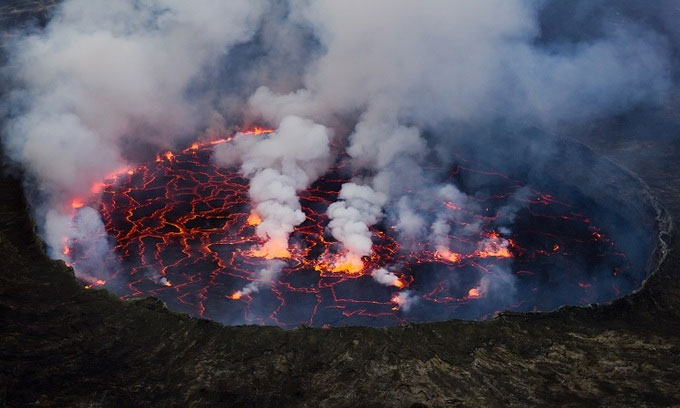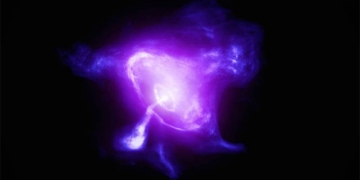The lava from the recent eruption has not yet reached the city of Goma, but monitoring results indicate that Mount Nyiragongo poses a significant threat.
Mount Nyiragongo remains relatively quiet. Located in the eastern Democratic Republic of Congo (DRC), it is one of the few places in the world with a boiling lava lake inside its crater at the summit.
On May 22, large cracks opened up on the volcano’s slopes, causing lava to flow rapidly down the mountainside. Some lava flows headed towards the city of Goma, a metropolis just 9 km away with a population of 1.5 million. The lava reached heights equivalent to three-story buildings, quickly spilling over the streets of several villages surrounding Goma, engulfing any structures in its path. The death toll has reached 15 and may rise in the coming days.
The two previous eruptions in 1977 and 2002 at Nyiragongo were disasters. In 1977, it is estimated that between 600 and 2,000 people died due to lava flows. In 2002, lava destroyed one-fifth of Goma, displacing 120,000 people and causing 250 deaths from asphyxiation, along with an explosion at a gas station.

Lava lake at the summit of Mount Nyiragongo. (Photo: Wikipedia).
These past disasters have raised concerns among volcanologists whenever Nyiragongo shows signs of activity. “This is one of the most dangerous volcanoes in Africa,” concluded Benoît Smets, a geological hazard expert at the Royal Museum for Central Africa in Tervuren, Belgium. The deadly threat of Nyiragongo arises from multiple factors. Due to the complex geology of the area, the lava from the mountain is particularly fluid, capable of moving at speeds of up to 64 km/h. Eruptions can also release large amounts of toxic CO2 gas, which is extremely concerning given that millions of people live near the volcano.
Due to political instability and conflict in the region, monitoring Nyiragongo is very challenging. Despite the efforts of the Goma Volcano Observatory, established in 1986, researchers did not detect any clear warning signs before the most recent eruption. Given all these factors, the volcano could produce a terrifying eruption, according to Corentin Caudron, a volcanologist at the Earth Science Institute in Grenoble, France.
Nyiragongo, standing at 3,475 meters in Virunga National Park of the DRC, exists due to two factors. First is the geological rift of East Africa. The land stretching from the Red Sea to Mozambique is being pulled apart. The Nubian tectonic plate to the northwest and the Somali tectonic plate to the southeast are moving in opposite directions at a rate of several centimeters per decade. This separation is known as the East African Rift.
The rifting process allows magma to rise and form volcanoes. Furthermore, a column of solid but superheated material from the mantle also erupts from deep within the Earth, interacting with the underside of the tectonic plate. The result is a strange mix of magma, according to Christopher Jackson, a geologist at the University of Manchester, UK.
Most of the magma contains a small amount of silica, a compound that acts as the framework of the lava. The less silica present, the thicker the lava is when it erupts. The magma currently erupting on the Reykjanes Peninsula in Iceland has a low silica content, making it relatively fluid, but it flows slowly on the flat surface. In contrast, Mount Nyiragongo’s lava is very low in silica, allowing it to spread rapidly across the ground, especially if erupted in large quantities. If the lava erupts from a great height, the steep slopes of the volcano can help it gain speed.
The lava from the volcano is also particularly rich in carbon dioxide, a colorless, odorless gas. This gas often silently escapes to the surface through the aquifer above the magma body. Being denser than air, carbon dioxide tends to accumulate in low-lying areas. If carbon dioxide-rich magma erupts from Nyiragongo, hazardous gas columns could also suddenly erupt from numerous cracks.
Eruptions at Nyiragongo typically occur when the pressure of accumulated magma or earthquakes open cracks on the slopes of the mountain, leading to flows from the lava lake or the eruption of magma stored deep below. However, each eruption often has its own characteristics. Therefore, monitoring eruption signs at this volcano is particularly challenging, and Nyiragongo is a perfect example.
Between eruptions, the crater at the summit of Nyiragongo is often filled with magma. In 2016, a second vent opened at the summit. In 2020, volcanologists observed that the lava lake was filling up faster than before. However, they could not determine whether the height of the lava lake was an indication that the volcano was ready to erupt.
On May 10, the Goma Volcano Observatory detected increased seismic activity at the summit. This could be evidence that magma is moving closer to the surface. The observatory’s efforts to monitor Mount Nyiragongo have been hampered by the theft and vandalism of several seismic measurement stations. Many locations remain unrepaired due to the risk of violence. The observatory also lost financial support from the World Bank last year. As a result, for several months, remote sensors have been disconnected from the internet. Researchers have also been unable to conduct regular on-site measurements.
By the morning of May 23, the eruption had decreased in intensity. The lava stopped flowing less than 300 meters from the edge of the city of Goma, leaving behind a river of solidified lava. The tragedy struck 17 nearby villages, destroying hundreds of homes, a school, three health centers, and water pipelines. Mount Nyiragongo continues to experience numerous tremors and some strong earthquakes shaking the region, revealing disturbances beneath the surface. However, scientists do not know when the next eruption may occur.




















































